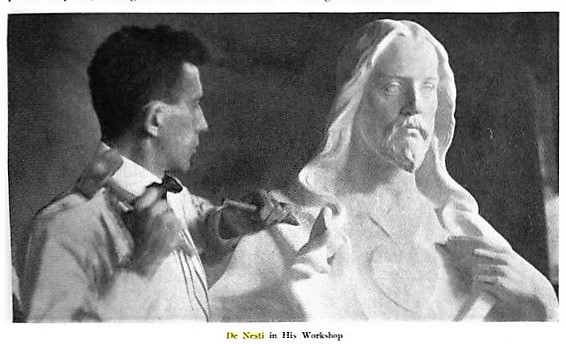 Standing in the darkness, behind a noisy blowing fan in a corner of St. Francis de Sales church, on the parking lot side, is a tall quiet statue of Jesus with broken fingers.
Standing in the darkness, behind a noisy blowing fan in a corner of St. Francis de Sales church, on the parking lot side, is a tall quiet statue of Jesus with broken fingers.
For the first few decades of our history, the statue took pride of place beside the altar, at the front of the church, clearly visible to the priest and congregation. Then, in the 1960s, the reforms of Vatican II called for the sanctuary to be “de-cluttered” to better focus on the modernized Communion ritual with its new forward-facing altar. The statue was moved, and moved again, until it found its current out-of-the-way resting place.
So what does the statue mean? Its upraised right hand, with two fingers and thumb outstretched, is a gesture of blessing – supposedly based on the ancient Roman orators’ gesture for “speaking.” Its wounded heart reveals “Jesus Christ′s physical heart as the representation of his divine love for humanity” — the crown of thorns showing that “the meaning of love in the life of Jesus was especially evident in His sufferings” and the flames representing “the transformative power of divine love.” Devotion to a representation of the Sacred Heart of Jesus – based on a vision experienced by a Visitation Sister in the 1670s — is a longstanding form of Catholic worship.
As to its place in our history: our statue of the Sacred Heart of Jesus was described as “a specimen of his best work” in an article about Adolfo de Nesti in 1915 – the last information we have about the Italian immigrant sculptor who created so many of our church decorations, before his “American dream” ended and he abruptly disappeared.
What is a metaphor? An online dictionary defines it as “a thing regarded as representative or symbolic of something else, especially something abstract.” So our statue depicting the “divine love” of Jesus was moved away from a central location to a dusty corner. We took its existence for granted, as part of the church furnishings, and it received little attention – especially after the candle stand illuminating that corner was removed a few years ago. The statue has changed with age, since the fingers making its gesture of blessing – and “speaking” – have been broken and roughly mended. But it has always been a part of our church.
Now, in shadowed times, as we rediscover our history, our attention is pulled back to the statue and we are called to find inspiration once again in the light and power of “divine love” that it represents.